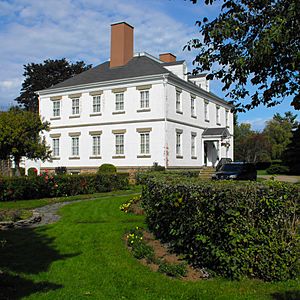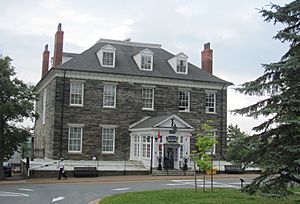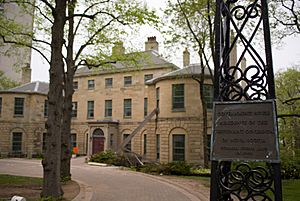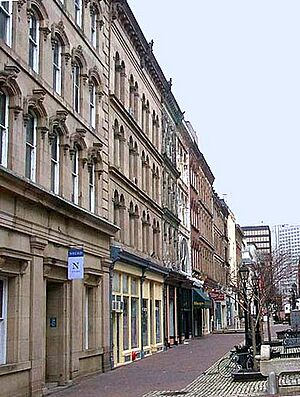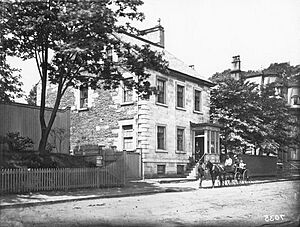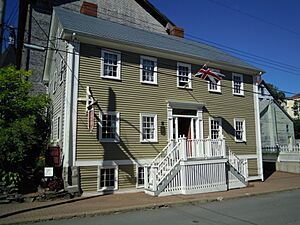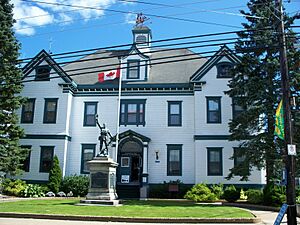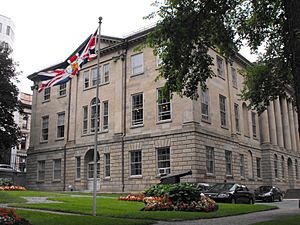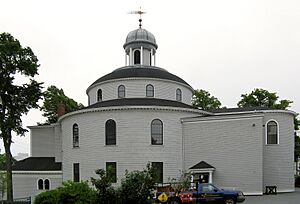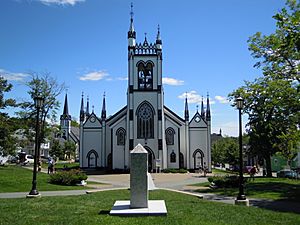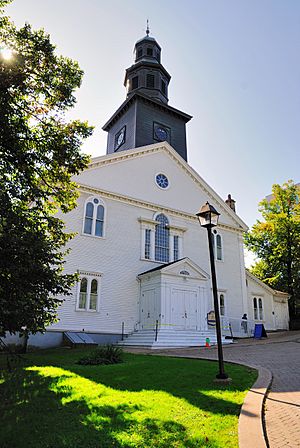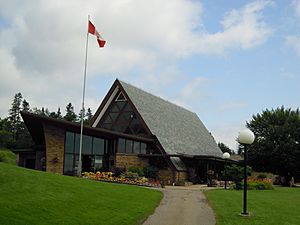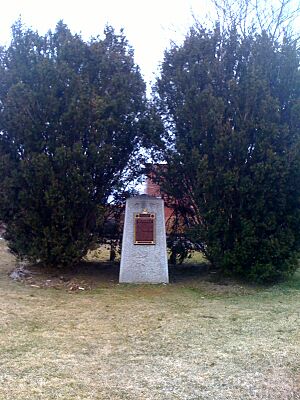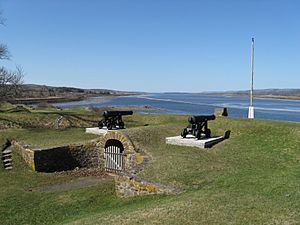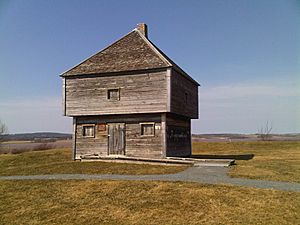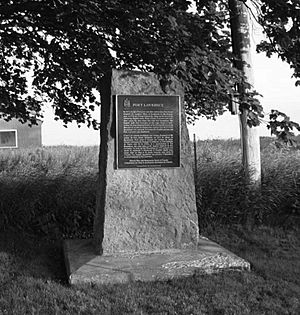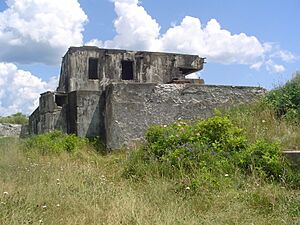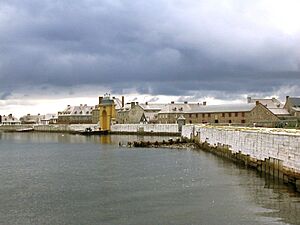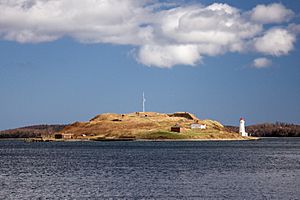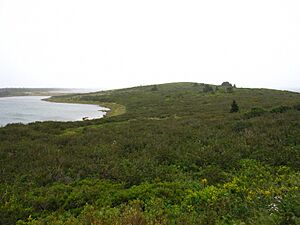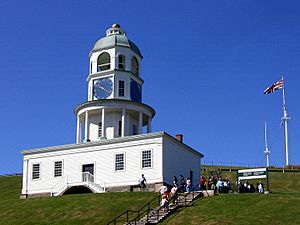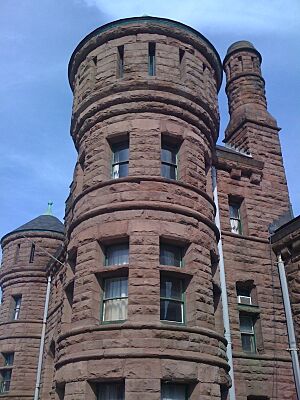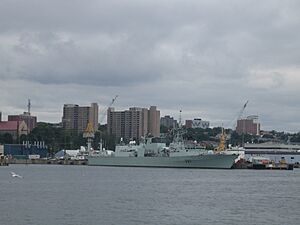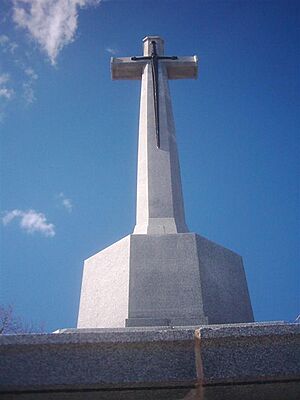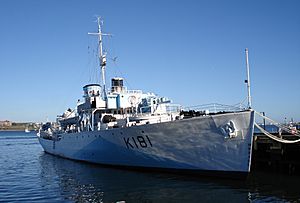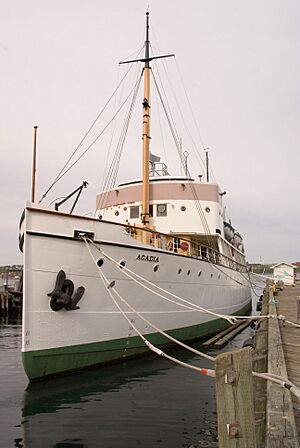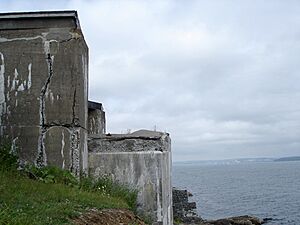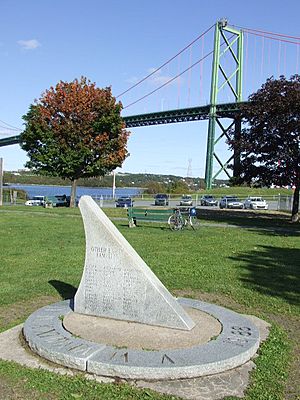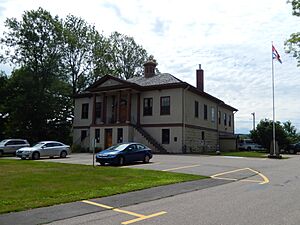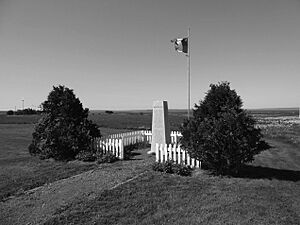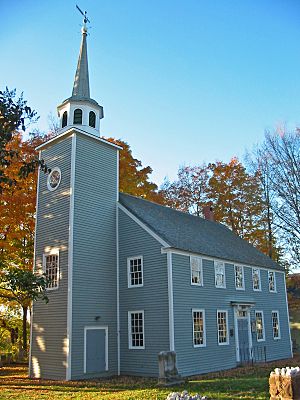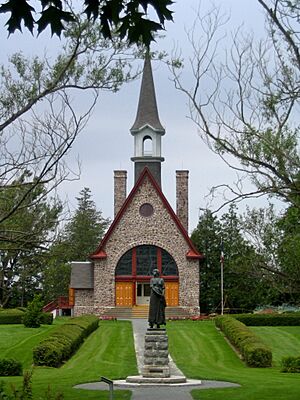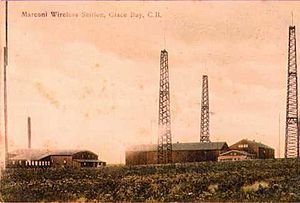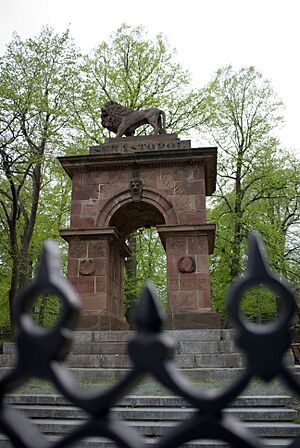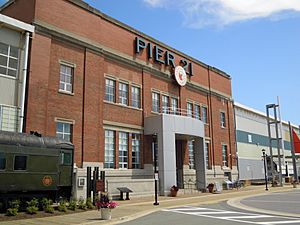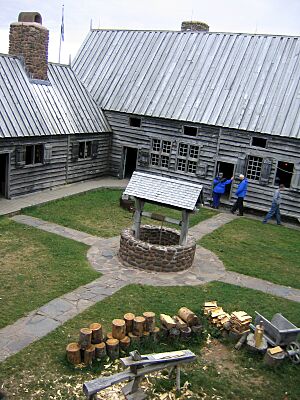List of National Historic Sites of Canada in Nova Scotia facts for kids
Nova Scotia is home to many special places called National Historic Sites (or Lieux historiques nationaux in French). These are spots that tell important stories about Canada's past. As of April 2021, there were 91 of these sites in Nova Scotia. Twenty-six of them are looked after by Parks Canada (you'll see a beaver icon ![]() next to them).
next to them).
Many important events and people from Canadian history are also remembered across Nova Scotia. You'll find special plaques marking these spots, just like the ones for National Historic Sites. This list uses the official names given by the Historic Sites and Monuments Board.
UNESCO World Heritage Site unit
Contents
Discovering Nova Scotia's Historic Places
Let's explore some of the amazing National Historic Sites in Nova Scotia! Each one has a unique story to tell about the people and events that shaped Canada.
Historic Homes and Buildings
- Acacia Grove / Prescott House
This house in Starr's Point was finished in 1809. It was built for Charles Ramage Prescott, who loved gardening. It's a great example of Georgian architecture, a popular style from that time.
- Admiralty House
Finished in 1819, this grand stone house in Halifax was once the home of the top commander of the Royal Navy in North America. It's now part of CFB Halifax.
- Akins House
Built around 1815 for Thomas Beamish Akins, this wood-shingled house in Halifax is one of the oldest homes still standing in the city. It looks almost exactly as it did when it was first built!
- Black-Binney House
This house, completed in 1819 in Halifax, shows off the Palladian architecture style that was common in Eastern Canada back then. Important people like John Black and Hibbert Binney lived here.
- Cast Iron Façade / Coomb's Old English Shoe Store
This building in Halifax, finished in 1860, has a special front made entirely of cast iron. It was one of the very first buildings in Canada to use this material for its facade.
- Chapman House
This two-storey, red-brick house in Fort Lawrence was completed around 1780. It's a good example of the large, comfortable farmhouses owned by wealthy people in the Maritimes during the 18th century.
- de Gannes-Cosby House
Built in 1708 in Annapolis Royal, this rare building survived the time before the Acadians were expelled. It was used by officers under both French and British rule.
- Fernwood
This house in Halifax, built around 1860, sits on a large, beautiful property. It's a great example of a Gothic Revival villa in Canada.
- Government House
Completed in 1805 in Halifax, Government House has been an official residence for over 175 years. It's one of the oldest official homes in Canada.
- Granville Block
This group of 19 buildings in Halifax was built after a big fire in 1859. It's a success story for saving old buildings, and today it's home to NSCAD University.
- Henry House
Finished in 1834 in Halifax, this stone house shows the style of homes built for important people in early British North America. William Alexander Henry, one of the Fathers of Confederation, lived here.
- Hydrostone District
Established in 1917 in Halifax, this area is a fantastic example of an English-style "garden suburb" in Canada. It was the country's very first public housing project.
- Jonathan McCully House
This Italianate style house in Halifax was completed in 1857. It was the home of Jonathan McCully, another Father of Confederation, from 1863 to 1877.
- Knaut-Rhuland House
This wooden house in Lunenburg, finished in 1793, is an early example of British classicism in Canada. It's part of the Old Town Lunenburg Historic District, a UNESCO World Heritage Site.
- Ladies' Seminary
Built in 1878 on the Acadia University campus in Wolfville, this building is Canada's oldest facility connected to higher education for women.
- Little Dutch (Deutsch) Church
This small wooden church in Halifax is surrounded by an old graveyard. It's the oldest church in Canada linked to the German Canadian community.
- Liverpool Town Hall
Completed in 1902 in Queens, this building used to be the town hall and is now a museum and theatre. Its simple, classic design is rare for town halls built in the 20th century.
- Lunenburg Academy
This eye-catching building, finished in 1895 in Lunenburg, sits on top of Gallows Hill. It's a rare example of an old academy building, showing how Nova Scotia's education system changed in the 19th century.
- Old Barrington Meeting House
Built in 1765 by settlers from New England, this wooden building in Barrington Head is one of the oldest surviving buildings in English-speaking Canada. It's a great example of a New England–style meeting house.
- Pictou Railway Station (Intercolonial)
Finished in 1904 in Pictou, this former train station has a mix of styles. It represents the Intercolonial Railway, which connected the Maritimes with Central Canada.
- Province House
Completed in 1819 in Halifax, Province House is the longest-serving government building in Canada. It's also where responsible government (where the government answers to the people) and freedom of the press began in Canada.
- Sinclair Inn
This old wooden hotel in Annapolis Royal has parts that date back to 1710! It's a mix of three centuries of building styles and techniques.
- Sir Frederick Borden Residence
The former home of Frederick William Borden in Canning, this house was renovated in 1902 in the Queen Anne style. It's a good example of this popular architectural style for homes.
- St. George's Anglican Church / Round Church
This unique round wooden church in Halifax, finished in 1812, is connected to the early history of the city. It's a wonderful example of Palladian architecture in Canada.
- St. John's Anglican Church
This Carpenter Gothic church in Lunenburg, completed in 1763, played a big role in establishing British rule and the Church of England in 18th-century Nova Scotia.
- St. Mary's Basilica
This large Gothic Revival church in Halifax, started in 1820, is important for the history of Roman Catholics in Nova Scotia and Canada.
- St. Paul's Anglican Church
Completed in 1750 in Halifax, this small wooden church was the first building in Canada built in the Palladian style. It was also the first Anglican cathedral outside of Great Britain.
- Thinkers' Lodge
This lodge in Pugwash is famous as the birthplace of the Pugwash movement in 1957. This movement worked for nuclear disarmament and world peace during the Cold War.
- Trinity Anglican Church
Finished in 1878 in Digby, this church is a good example of the work of architect Stephen C. Earle. It shows the American Ecclesiological Gothic Revival style.
- Truro Old Normal College
Built in 1877 in Truro, this college is a great example of Second Empire architecture. It also shows how teacher training was improved and standardized in the 19th century, helping to develop Nova Scotia's public education system.
- Truro Post Office
Completed in 1886 in Truro, this post office is a good example of the buildings designed by Thomas Fuller, the government's chief architect, for smaller towns across Canada.
Important Forts and Military Sites
This museum in Baddeck holds many items belonging to Alexander Graham Bell, the inventor of the telephone. It's on a large property overlooking Bras d'Or Lake, near Bell's summer home.
Located near Bridgetown, this site saw two battles in 1711 and 1757. British forces fought against French and Indigenous allies for control of Acadia. A stone monument marks the 1757 battle.
This group of islands near Canso was an important fishing base for the French in the 16th century and the British in the 18th century. It was a starting point for the 1745 attack on Louisbourg.
Established in 1629 in Annapolis Royal, this was the site of William Alexander's attempt to create the colony of "Nova Scotia." Scottish colonists lived here for three years before the land was given back to France.
In 1746, Duc d’Anville's French forces camped here along the shore in Halifax. Their mission to take back Acadia failed.
The remains of this fort in Annapolis Royal, established in 1629, played a huge role in early European settlement and the fight between Britain and France for control of Acadia and Nova Scotia.
This fort in Windsor, established in 1750, was important during the Seven Years' War, the expulsion of the Acadians, and the defense of Canada during the American Revolutionary War and the War of 1812. Today, you can see a wooden blockhouse and parts of the old fortifications.
These are the archaeological remains of a fort built by the British in 1750 in Fort Lawrence. It was meant to defend the Isthmus of Chignecto but was abandoned after the British captured Fort Beauséjour in 1755.
Completed in 1892 on McNabs Island, these are the remains of defenses built to protect Halifax, which was a major naval base for the British Empire. It shows how defense technology changed in the late 1800s.
- Fort St. Louis
Established in 1623 in Port La Tour, this fort was France's only foothold in Acadia when the Scottish occupied Port Royal from 1629 to 1632.
This site in LaHave, Nova Scotia is where Isaac de Razilly built a fort and settlement, making it the capital of the Acadian colony in 1632 after the land was returned to France.
Established in 1713 in Louisbourg, this is the largest rebuilt 18th-century French fortified town in North America. It played a key role in the battles between the French and British empires.
This island in the middle of Halifax Harbour was very important for the "Halifax Defence Complex." It helped protect one of the British Empire's main naval bases during the 18th and 19th centuries.
These are the remains of early 18th-century British fortifications near Canso. It was part of the larger Canso Islands National Historic Site.
This stone fortress in Halifax, started in 1828, was built to defend one of the British Empire's four main naval stations. It's a key part of Halifax's unique shore defenses.
- Halifax Drill Hall
Completed in 1899 in Halifax, this drill hall is a good example of the Richardsonian Romanesque style. It shows how drill halls were built in Canada between 1872 and 1895.
- Halifax Dockyard
Created in 1758 under the guidance of Captain James Cook, this was the very first Royal Navy shipyard in North America. It's still used by the Royal Canadian Navy today.
- Halifax WWII Coastal Defences
During the Second World War, Halifax was Canada's most heavily defended port. It was the main meeting point for Allied convoys during the Battle of the Atlantic.
- HMCS Sackville
Launched in 1941, the HMCS Sackville is one of the last Flower-class corvettes left. These ships played a vital role in the Battle of the Atlantic during WWII.
- Melville Island and Deadman's Island
From the 1790s to 1856, and again from 1909 to 1939, these islands in Halifax served as a prison for war prisoners, a military prison, a medical facility, and a place for people to wait before entering the country.
Completed in 1799 in Halifax, this large martello tower was important in developing Halifax as a major British naval station.
This archaeological site in Louisbourg, completed in 1728, was built by the French to defend Louisbourg harbour. It played a big role in the sieges of Louisbourg in 1745 and 1758.
- S.S. Acadia
Launched in 1913, the S.S. Acadia is a steel ship now docked in Halifax. It was a pioneering research vessel that helped map Hudson Bay.
- Sainte-Anne / Port Dauphin
Established in 1629 in Englishtown, this site was founded as a Jesuit mission and later a naval base. Its importance faded when Louisbourg became the capital in 1719.
- Sydney WWII Coastal Defences
During the Second World War, Sydney was a safe port protected by seven coastal gun batteries. It was crucial for the RCN and RCAF to keep supply routes open across the North Atlantic.
In 1758, during the Seven Years' War, British forces led by James Wolfe landed here in Cape Breton Regional Municipality. This was where they launched their successful attack on the French at the Fortress of Louisbourg.
Established in 1793 in Halifax, these defenses protected Halifax Harbour from the American Revolutionary War until the Second World War. They show how the harbor's defense system changed over time.
Places of Community and Culture
- Africville
This Black Nova Scotian community in Halifax was cleared by the city in the 1960s for "urban renewal." It became a strong symbol of the need to protect Black communities and their history.
- Annapolis County Court House
Completed in 1837 in Annapolis Royal, this is one of the oldest court houses in Canada still being used for its original purpose. It's a notable example of Palladian architecture in Canada.
- Annapolis Royal Historic District
Established in 1605, this historic area in Annapolis Royal has buildings from the 18th to early 20th centuries. It was the center of the original 17th-century Acadian settlement and saw many key events in Canada's early colonization.
- Antigonish County Court House
Completed in 1855 in Antigonish, this wooden building with a Greek Revival front is one of the best examples of mid-19th century Maritime court houses.
- Argyle Township Court House and Jail
This two-storey wooden building in Tusket, completed in 1805, is now a museum. It's the oldest known surviving building that combined a court house and a jail.
This archaeological site near Fort Lawrence has remains of a major Acadian settlement from 1672. It was very important in the 17th and 18th-century struggles between the British and French for the region.
- Bedford Petroglyphs
This site in Halifax has ancient petroglyphs (rock carvings) that are about 800-1,000 years old and have spiritual meaning. Kejimkujik National Park also has over 500 Mi'kmaq petroglyphs.
- Beinn Bhreagh Hall
Built in 1892-93 in Victoria County, this was the home of inventor Alexander Graham Bell and his family. Its name means "Beautiful Mountain" in Scottish Gaelic, reminding Bell of his birthplace.
- Chapel Island
For centuries, this island in Chapel Island First Nation has been a very important gathering place, government location, and spiritual site for the Mi'kmaq people.
- Covenanters' Church
This simple Presbyterian church in Grand-Pré, completed in 1811, is like the New England meeting houses of the 18th century. It's also part of the Grand-Pré Rural Historic District.
- Debert Palaeo-Indian Site
This is the oldest archaeological site in Nova Scotia, located in Debert. It's one of the most important Paleo-Indian sites in the province, with artifacts dating back 10,600 to 13,000 years!
- Former Shubenacadie Indian Residential School
This site in Shubenacadie was the only residential school in the Maritimes from 1930 to 1967. Here, the government and churches worked to assimilate (make them like the dominant culture) Indigenous children.
This site in Grand-Pré was a center of Acadian settlement and culture from 1682 until 1775. It also served as the British headquarters for the deportation of the Acadians from Nova Scotia between 1755 and 1763. It is a UNESCO World Heritage Site.
- Grand-Pré Rural Historic District
This rural area around Grand-Pré and Hortonville has some of the oldest European land use patterns in Canada. It shows how the first Acadian settlers adapted to North America. It is a UNESCO World Heritage Site.
- Halifax City Hall
Completed in 1890 in Halifax, this three-storey building with a seven-storey clock tower is a symbol of city halls built in Canadian cities during the 19th century.
- Halifax Court House
This impressive sandstone court house in Halifax, completed in 1860, is built in the neoclassical style. It represents the justice system of Nova Scotia.
- Halifax Public Gardens
Established in 1874 in Halifax, these gardens are a rare example of a Victorian public English landscape garden in Canada. They still have their original design and plants.
- Halifax Waterfront Buildings
Built between 1815 and 1905, this group of restored stone and wooden warehouses on the Halifax waterfront are now offices, shops, and restaurants. They are the most important group of commercial buildings from before Confederation in the Maritimes.
This entire area of Kejimkujik National Park is a cultural landscape. It has petroglyph sites, living areas, fishing and hunting spots, travel routes, and burial grounds that show the Mi’kmaq have lived here for thousands of years.
- King's College
Established in 1789 in Windsor, this was the first university in the British Empire's Dominions. It was the original site of the oldest university in what would become Canada (its campus is now in Halifax).
This isolated site in Glace Bay is where Guglielmo Marconi received the first transatlantic radio telegraph message in 1902. You can still see the remains of his telegraph towers.
- Marconi Wireless Station
Established in 1905 in Cape Breton Regional Municipality, this site has the foundations of old radio towers. It was the location of the wireless station that, along with a station in Ireland, provided the first regular public intercontinental radio service starting in 1908.
These are the remains of an Acadian village in the salt marshes of the Annapolis River from before the expulsion. It shows how Acadian settlements and their unique farming methods worked.
- Nova Scotia Coal Fields (Sydney)
These sites in Sydney have remains of the coal fields and coal industry, which are unique to Nova Scotia.
- Nova Scotia Coal Fields (Stellarton)
These sites in Stellarton also have remains of the coal fields and coal industry, showing their importance to the province.
- Old Burying Ground
Established in 1749 in Halifax, this early graveyard is surrounded by a stone wall. It has a unique collection of gravestone art, showing the cultural traditions of early British North America.
- Old Town Lunenburg Historic District
Established in 1753 in Lunenburg, this is a very well-preserved example of 18th-century colonization and settlement patterns. It's a UNESCO World Heritage Site and one of the earliest and most complete British town plans in Canada.
- Pictou Academy
The original site of the Pictou Academy in Pictou, founded by Thomas McCulloch in 1818, is marked by a stone monument. The Academy brought non-religious education to the Maritimes.
- Pier 21
Completed in 1928 (and rebuilt in 1944) in Halifax, this ocean passenger terminal saw a huge wave of immigration to Canada from Europe after the Second World War. It's the last complete example of its kind and represents Canadian immigration in the early 20th century.
This is a rebuilt 17th-century French fort in Annapolis County, originally established in 1605. It represents the history of the local Acadian and Mi'kmaq peoples and was a big step in saving Canadian heritage in the 20th century.
This archaeological site in St. Peter's, established in 1630, has remains from 17th and 18th-century Mi’kmaq and Acadian communities. It was also the site of Fort Saint-Pierre, a fortified trading post, and Port-Toulouse, a French community.
Completed in 1869 in St. Peter's, this canal connects Bras d'Or Lake with St. Peter's Bay on the Atlantic Ocean. It's a cultural landscape linked to the building and use of the canal.
See also


